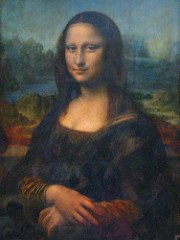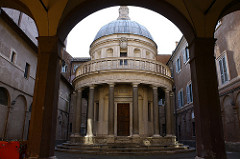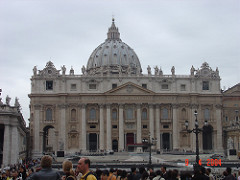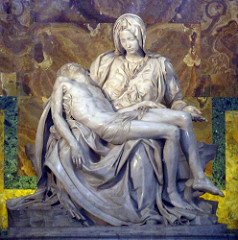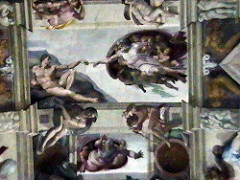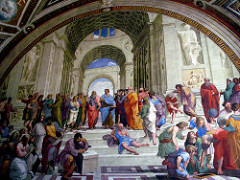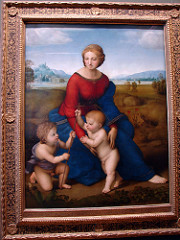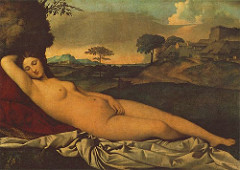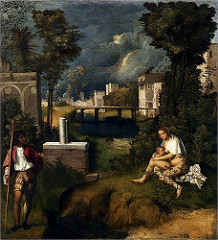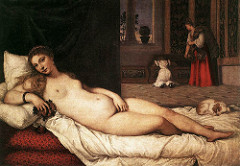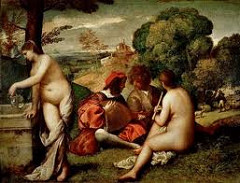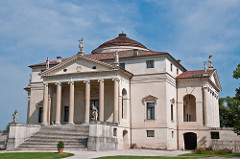Leonardo da Vinci
…, Italian painter, engineer, musician, and scientist. The most versatile genius of the Renaissance, Leonardo filled notebooks with engineering and scientific observations that were in some cases centuries ahead of their time. As a painter Leonardo is best known for The Last Supper (c. 1495) and Mona Lisa (c. 1503).
Madonna of the Rocks
Leonardo, Leonardo Da Vinci, High Renaissance.
Leonardo used gestures and a pyramidal composition to unite the Virgin, Saint John the Baptist, the Christ Child, and an angel. The figures share the same light-infused environment. Uses “sfumato”, Artist or Architect: Leonardo da Vinci
Date of Work: (1483-1508)
Medium: Oil on panel
Location: Altarpiece for a Franciscan church in Milan
Significance:
– Traditional iconography: Mary, infant Jesus, John the Baptist, angel pointing at the womb
-Example of Leo’s fully developed painting style
-sfumato: smoked, hazy, darker quality, toned varnish
-Removing figures from the worldly realm
-Natural forms
The Last Supper
c. 1495-98 Frescoe in refrectory of a Dominican friary in Milan. Portrayed dramatic moment when Jesus told his apostles that one of them would betray him. Tremendous expression on faces of each apostle. Very dramatic use of one point perspective. Painted by Da Vinci.
The Mona Lisa
…, Painted by da Vinci (1504-1506) it is one of the best-known portraits in the world, the woman seems so real that many writers have tried to explain her smile. It is thought to have been Lisa Gheradini, who at 16, married Francesco del Giocondo, a wealthy Florentine merchant. Mona Lisa would then be a shortened version of Madonna Lisa., -Leonardo Da Vinci
-Is one of the most famous pieces in western art
-Was painted in a style that is lifelike
-With pyramid configuration
-Linear perspective
-Vanishing point
-Perspective
-(1503-1519)
-Italy
-Oil on poplar panel
Notebooks
…, had sketches, drawings, ect.
extremely long, about 5000 pages
safeguarded his ideas by using left handed mirror writing, leaving out things he remembered, misinformation, didn’t want people to take credit for his ideas and afraid people would abuse his ideas
Ludovico Sforza
Ludovico Sforza played the part of the archetypical Italian Renaissance prince, surrounding himself with intrigue and corruption. Though Ludovico was not the rightful duke of Milan and was known to use coercion and manipulation to achieve his political goals, for a time the city of Milan flourished in his care. Under Ludovico, known as ‘Il Moro,” Milan became extraordinarily wealthy and its citizens participated in a splendid and excessive social culture., Duke of Milan and best known for commissioning the Last Supper (famous painting). He controlled Milan for 13 years, and supported the arts and culture.
Sfumato
Painting technique in which contours are enveloped in a suggestive, smoke-like haze, A smokelike haziness that subtly softens outlines in painting; particularly applied to the painting of Leonardo and Correggio.
Donato Bramante
architecture; “The Tempietto” (little temple) on top of St. Pieter’s martyrdom; Pope Julius II asks him to design a basilica for Rome– Saint Peter’s, -great architect of (High Renaissance1500-1530, when painting, sculpture, + architecture all reached peak of perfection and center of art activity shifted from Florence to Rome)
-commissioned by Pope Julius II to replace old basilica of St. Peter w/ monumental Renaissance structure planned for centralized church in form of Greek cross surmounted by immense dome (exemplifies spirit of HR to approach grandeur + monumentality of Roman arch.)
Tempietto
Little Temple; 15 ft. diameter; Doric style columns, Donato Bramante, 1502, The temple has features of classical architecture such as columns, classical reference to ancient Roman temples, sculptural achietchture which are proportions are given three dimensional articulation, -Bramante
-location of St. Peter’s crucifixion
-classical features: columns, dome, architrave
-balustrade- mini columns
-1502
Pope Julius II
the Warrior Pope, famous for his military prowess and diplomatic intrigue; commissioned Michelangelo to paint the Sistine Chapel and secured the Papal States
New St. Peters
Rome, Italy; 1506-1615; Bramante built the crossing piers of St. Peter as of 1536; Antonio da Sangallo the younger’s model (1539-1546); Michaelangelo plan(1546); dome has 2 layers like florence dome; Maderno’splan: extended the front of the cathedral;, constantine’s; long aisles; narthex; beman; and a public gathering area
Michelangelo
An Italian painter, sculptor, and architect of the fifteenth and sixteenth centuries. Among many achievements in a life of nearly ninety years, Michelangelo sculpted the David and several versions of the Pietà, painted the ceiling and rear wall of the Sistine Chapel, and served as one of the architects of Saint Peter’s Basilica, designing its famous dome. He is considered one of the greatest artists of all time.
Pieta by Michelangelo
Pietà was a Renaissance sculpture created by Michelangelo that depicted Jesus after his death on the cross in the Virgin Mary’s arms. It is currently in St. Peter’s Basilica. It is made of marble.
The David by Michelangelo
isculptor by Michelangelo
-in Florence
-sculpted Goliath without sculpting Goliath by having David looking at someone else
-Marble
-1500-1504
-Classical contriposto
-Eyes darted to the left and right arm relaxed
-commisioned by the city governmant of Florence
-meant to be up high on a tribune but after he finihsed they wanted it in the pizzaza in front of the scenary and infront of the governemnt building of Florence
-David symbolizes Florence
The tomb of Pope Julius II
-Michelangelo
-Sculptural and architectural ensemble by Michelangelo and his assistants
-Originally commissioned in 1505 but not completed until 1545 on a much reduced scale.
-Originally intended for St. Peter’s Basilica, the tomb was instead placed in the church of San Pietro in Vincoli on the Esquiline in Rome after the pope’s death
-Marble
– Moses 8 feet sitting down
Sistine Chapel ceiling
Artist or Architect: Michelangelo
Date of Work: 1508-1512
Medium: Fresco
Significance:
-Michelangelo always saw himself as a sculptor, so painting was an issue for him
-Two main biographies: Vasari (1550, Lives of the Artists), Ascanio Condivi (1553 commissioned by himself)
-Assumption that Michelangelo would fail at the painting of the chapel, “they thought I couldn’t do it,” a way to get him out of good favor with the pope
-Julius wanted a cycle of the 12 apostles, but Michelangelo proposed sequence of narratives of the book of Genesis along with prophets
-Cultivates the idea of the artist–> cannot be treated like a laborer or as a craftsman
The Last Judgement
From 1537 to 1541. Not necessarily on the 1st of January. Painted by Michelangelo. A fresco painting on the Sistine Chapel altar wall in Vatican City. It is a depiction of the second coming of Christ and the final and eternal judgment by God of all humanity. The souls of humans rise and descend to their fates, as judged by Christ surrounded by his saints.
Rondanini Pieta by Michelangelo
…, (Michelangelo) – his final sculpture, started in 1550 and never really finished, shows virgin mary mourning over the body of christ, marble
Raphael
(1483-1520) Italian Renaissance painter; he painted frescos, his most famous being The School of Athens., 1483-1520 Short but productive life. Worked in Florence and Rome. Well-known for Madonnas, humanized portrayals of the Virgin Mary with the baby Jesus. Painted frescoes in Vatican Palace – espec. The School of Athens & The Triumph of Religion – reflect artist’s strong interest in classical antiquity and Christian religion.
The School of Athens by Raphael
Raphael – Italian Renassaince fresco wall painting of Greek philosophers drawn to scale in accordance with the vantage point of the viewer. The placement, in the center of the archway, of Plato and Aristotle emphasizes the importance of these two central figures. Raphael shows his style of basic one-point perspective converging in a single vanishing point just behind Plato and Aristotle. The exception is the cube in the foreground which gives a two-point perspective. It easy to see, that with the removal of the figures, the building is symmetrically balanced.
Madonna in the Meadow by Raphael
Raphael; 1505; pyramidal composition; brighter, more conventionally beautiful image of the Virgin than Leo’s, fresco
Galatea
Raphael 1513, from the story Pygmalion and Galatea; she was a statue that Pygmalion loved very much and then was given life by the goddess Aphrodite
fresco
Venice High Renaissance
Venice was a Republic during the Renaissance. Actually, Venice was an empire that controlled land in modern day Italy, a whole lot of sea coast down the Adriatic and countless islands. It enjoyed a stable political climate and thriving trade economy, both of which survived outbreaks of the Black Death and the fall of Constantinople (a major trading partner). Venice was, in fact, so prosperous and healthy
Giovanne Bellini
adopted the technique of oil glazing and revolutionized Venetian painting. His most famous students, Giorgione and Titian adopted his glazing technique and which permitted beautiful color and rich tone which was has been unsurpassed, born in 1460 died in 1516 Bellini painted Agony in the Garden, showing the influence of Mantegna with a similar use of light and foreshortenin
Madonna and Child with Saints
-Tempera and oil on wood
-1505
-Giovanni Bellini
-Reveals a variety of drawing styles
Feast of the Gods
-Giovanne & Titian
-Oil
-1514
-Rustic Olympian gods in a dominating landscape
-Use of color to establish a mood
-Duke Alfonio de Este
-Background altered, originally more flowy
-Had been painted over
-Depicted god’s presence
-Textual interpretation of ovid’s fasti
Giorgione
1477-1510, first master of the Venetian high Renaissance, made “Giorgeonesque” “Sleeping Venus”, This Venetian painter is credited with making landscapes viable subject matter for paintings.
Dresden Venus
-The Sleeping Venus, also known as the Dresden Venus, is a painting by the Italian Renaissance master Giorgione, with, it is now generally accepted, the landscape and sky, by Titian, completed after Giorgione’s death in 1510, as Vasari first noted
-1510
-oil on canvas
The Temptest
-1506-1508
-oil on canvas
-On the right a woman sits, suckling a baby. She could be a gypsy, or to some people’s eyes a prostitute. Her pose is unusual – normally the baby would be held on the mother’s lap; but in this case the baby is positioned at the side of the mother, so as to expose her pubic area. This appears to signal that the mother’s realm is the everyday rather than the sacred. A man, possibly a soldier, holding a long staff or pike, stands in contrapposto on the left. He smiles and glances to the right, but does not appear to be looking at the woman.
Recumbent
(adj) in a reclining position, lying down, in the posture of one sleeping or resting
Titian
Greatest Renaissance painter in Venice, used vivid color and movement, which was the opposite of the subtle colors and static figures in Florentine paintings., 1477 – 1576 Tiziano Vecellio; most famed Venician painter of the Ren.; used rich colors, painted both religious works & portraits of important figures with about 1 painting per month
Venus of Urbino
Titian, c. 1538. Oil on canvas, high ren., -Florence, Italy
-1538
-Oil on canvas
-Titian Vecellio
-High Renaissance
-Naked woman looking out to the viewer
-Warmth/softness in the human flesh
-Set the standard for representations of the reclining female nude
Pastoral Symphony
Pastoral Symphony, is a great presentation of a renaissanceVenetian painting. The Venetian style differed from other paintings in renaissance Italy because of the use of vivd color in Venetian style paintings,
– 1508,
-Italy Renaissance,
-Oil on canvas
Used poesia, artist evokes a pastoral mood, characters symbolize the poet and his poetry, and his muses., VENETIAN- Giorgione/ and or Titian
Oil; arcadian pastoral mood, leonardo’s influence, emphasis on warm flesh tones, poetically inspired, no true meaning, thick oil, painterly, sumotto-hazy look
Assumption of the Virgin
-Titian
-1516-1568
-Italy Renaissance
-Oil on wood
-Depiction of the Virgin Mary’s ascent to Heaven
-Light conveyed through color
-Golden clouds seem to glow and radiate light into the church
Madonna of the Pesaro Family
painted by Titian. in this dynamic composition presaging a new kind of pictorial design. He placed the figures on a steep diagonal and the Madonna well off the cental axis. Bishop Jacopo Pesaro commissioned hm and presented it to the church of Frari, Titian
Italian (Venetian)
High Renaissance
1519-1526
Meeting of Bacchus and Ariadne
-1520-1523
-Oil on canvas
-By Titian
-Ariadne has been left on the island of Naxos, deserted by her lover, whose ship sails away to the far left
-She is discovered on shore by the god Bacchus, leading a procession of revelers in a chariot drawn by two cheetahs
-Bacchus is depicted in mid-air as he leaps out of the chariot to protect Ariadne from beasts
-In the sky above the figure of Ariadne is her crown, which Bacchus has thrown into the sky and becomes the constellation Corona
-shows her initial fear of Bacchus, but he raised her to heaven and turned her into a constellation, represented by the stars above her head
Sacra Conversazione
Italian, “holy conversation”; a style of altarpiece painting popular after the middle of the 15th century, in which saints from different epochs are joined in a unified space and seem to be conversing either with each other or with the audience.
Patron Isabelle d’Este
Isabelle d’Este was an important political figure in the 16th century. Her husband was taken prisoner by the Venetians or the Holy Roman Empire. They requested that Isabelle would turn over her son, Frederico, to be kept in her husband’s place, however she refused. She wrote to both the emperor and her husband, explaining why she refused. She detailed that her life without her son was like having no life at all. She remained firm, calling it an unchanging resolution. She wrote to her husband telling him that she has acted more lovingly to him than he did to himself. She signs it by saying that the letter was written with her own hand. Isabelle was known as the “First Lady of the Renaissance.”
Villa Rotonda
Palladio’s most famous villa. It has four facades, each one resembling a Roman temple with a columnar porch. In the center is a great dome-covered rotunda modeled on the Pantheon.

